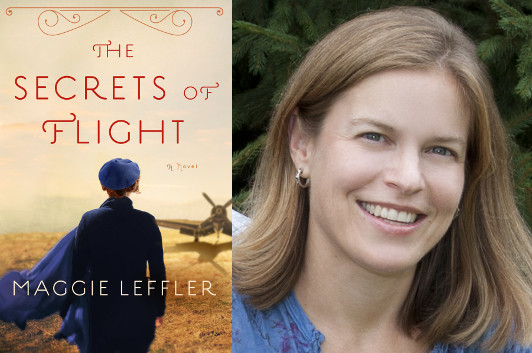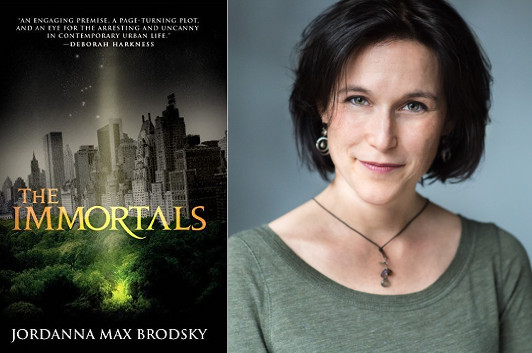Maggie Leffler’s Long Path to Flight

photo: Hills Studio
I first got to know Maggie Leffler just over nine years ago, when her debut novel, The Diagnosis of Love, came out. Now I’m reading her third book, The Secrets of Flight, and I’m hooked by its interlocking stories about two young women trying to figure out who they want to be… and how to become it—but also, as you’ll see, what happens years later, after the choices you’ve made and the circumstances you can’t control. Now, one of the reasons it’s been so long since a follow-up to Leffler’s first two books is that she has a full-on career as a family physician, but as you’ll learn in this guest essay, it also took her longer than she’d anticipated to find the right shape for this particular narrative. She did, though, and that’s great news for us.
Madeleine L’Engle once wrote, “I think that all artists, regardless of degree of talent, are a painful, paradoxical combination of certainty and uncertainty, of arrogance and humility… and yet with a stubborn streak of faith in their own validity no matter what.” Over the last six years of writing my third novel, these words have never felt truer.
In 2009, after reading about President Obama honoring World War II’s forgotten “fly girls” with Congressional Gold medals, I set out to write a family saga from four points of view, including that of a Women Airforce Service pilot (WASP). After it was completed in 2012, my agent sent The Secrets of Flight out to a round of rejections. The manuscript was overstuffed with characters, and, to boot, one of them, Jane, was unlikable (poor Jane!). Two drafts later, after the novel went out again—sans Jane—to be met with more rejections, I was in despair, yet compelled to keep writing all the same. Sometimes it’s not conviction urging me onward, but the story itself that needs to come out before I’m consumed.
That same summer, I confessed to my husband a secret dream of mine since the age of fourteen: I wanted to make a film, but I was scared to learn how. What if my attempts were awful? He pushed me to take a class at Pittsburgh Filmmakers, which gave me a different perspective for the book—or at least a healthy break from it. With each passing year, it became easier to kill another darling.
Soon the novel belonged to the two main characters I’d conjured up in the very beginning: Mary, the former WWII pilot with a secret, and Elyse, the big-hearted teen who would save her. Another distinct point of view also emerged, that of the young pilot’s… except that I had no idea what it felt like to have flown planes during the war. Finding the answers led to a friendship with Florence Shutsy-Reynolds, a Women Airforce Service pilot who inspired me with her stories. Finally, in 2014, the novel was ready for another round.
8 May 2016 | guest authors |
Jordanna Max Brodsky: The Heroine We Deserve, the Sidekick She Needs

photo: Ben Arons
I’m actually a bit jealous of the folks at Orbit who got to publish The Immortals, the debut novel by Jordanna Max Brodsky. I was lucky enough to read this story, which places the classical Greek pantheon into the modern suspense thriller, when it was making the rounds, and I was immediately impressed by the strength of Brodsky’s voice—it’s not just that the premise is cool, but that she fleshes it out with great characterizations, too. In this guest essay, she pulls back the curtain and explains some of the work that went into making her divine and human characters equally compelling. What she reveals makes perfect sense in retrospect, but she’s done it so well that it wouldn’t occur to you—or at least it didn’t to me—to think about the mechanics involved while you’re engrossed in the story.
I consider myself an unrepentant nerd. Academic over-achiever, Star Wars aficionado, player of board games, avoider of all things athletic. The heroine of The Immortals, on the other hand, is Selene DiSilva, a bow-wielding, ass-kicking, hard-as-nails vigilante who also just happens to be the Greek goddess Artemis living in modern day Manhattan. So my nerdophilic proclivities wound up centered squarely on the male protagonist of the book instead: Theodore Schultz, classics professor. Selene is stronger than he is, far more violent, and less emotionally vulnerable. In my mind, they make a perfect opposites-attract couple.
Most of my female friends agreed with my perspective when I asked them to read a draft. Theo is just the kind of guy they want around—a talker, a listener, and all around brilliant thinker. Then I let some male friends give me feedback and… boom! My blithe reversal of gender stereotypes ran smack dab into a brick wall of testosterone.
“Why is Theo a wimp?” they demanded. (He’s not a wimp, I’d reply, he’s just not into violence.) “Why is he such a nerd?” they asked. (He’s a classicist! Did you expect him to be the cool kid in school?)
Cue the throwing up of hands, the rolling of eyes, the “Why don’t you just make him a detective? Make him cool and calm and tough.” Then my equally frustrated reply: “Because Selene is all those things! She used to be a cop! She’s the Huntress, for goodness sake. She certainly doesn’t need a man to teach her how to track a killer or use a bow.”
18 April 2016 | guest authors |

 Our Endless and Proper Work is my new book with Belt Publishing about starting (and sticking to) a productive writing practice.
Our Endless and Proper Work is my new book with Belt Publishing about starting (and sticking to) a productive writing practice. 
